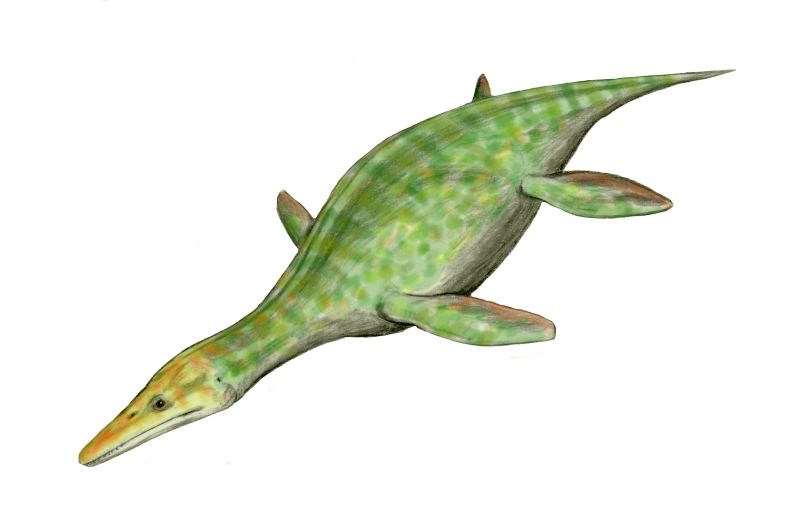- Pliosaur
Taxobox
name = Pliosaurs

image_caption = "Peloneustes philarchus "
fossil_range =Late Triassic -Late Cretaceous
regnum =Animal ia
phylum = Chordata
classis = Sauropsida
superordo =Sauropterygia
ordo =Plesiosauria
subordo = Pliosauroidea
subordo_authority = Welles, 1943
subdivision_ranks = Families and genera
subdivision = see textThe Pliosaurs ("more lizards") were marine reptiles from theJurassic andCretaceous Periods. They originally included members of the family Pliosauridae, of the OrderPlesiosauria , but several other genera and families are now also included; the number and details of which vary according to the classification used. The name is derived from Greek: "πλειω" from the verb 'to sail' or "πλειων" meaning 'fin' and "σαυρος" meaning 'lizard'. The pliosaurs, along with their relatives, the trueplesiosaur s, and other members of Sauropterygia, were notdinosaur s.The group was characterised by having a short neck and an elongated head, in contrast to the long-necked
plesiosaur s. They were carnivorous and their long and powerful jaws carried many sharp, conical teeth. Pliosaurs range from 4 to 15 meters in length. [ [http://www.zoomdinosaurs.com/subjects/dinosaurs/glossary/indexp3.shtml#Pliosaur zoom dinosaurs] ] [ [http://news.bbc.co.uk/2/hi/science/nature/7264856.stm Sea reptile is biggest on record] . BBC News,February 27 ,2008 .] Their prey may have includedfish ,ichthyosaur s and other plesiosaurs.Typical genera include "
Macroplata ", "Kronosaurus ", "Liopleurodon ", "Pliosaurus " and "Peloneustes ". Fossil specimens have been found inEngland ,Mexico ,South America ,Australia and theArctic region nearNorway .Many very early (from the
Rhaetian (Latest Triassic) andEarly Jurassic ) primitive pliosaurs were very like plesiosaurs in appearance and indeed used to be included in the familyPlesiosauridae .Taxonomy
The taxonomy presented here is mainly based on the plesiosaur cladistic analysis proposed by O'Keefe in 2001 O'Keefe, F. R. 2001. A cladistic analysis and taxonomic revision of the Plesiosauria (Reptilia: Sauropterygia). Acta Zoologica Fennica 213: 1-63. ] and Smith & Dyke in 2008 Smith AS, Dyke GJ. 2008. The skull of the giant predatory pliosaur "Rhomaleosaurus cramptoni": implications for plesiosaur phylogenetics. "Naturwissenschaften" e-published 2008.]
*Suborder: †Pliosauroidea Welles, 1943 sensu O'Keefe, 2001
**†"Attenborosaurus " Bakker, 1993
**? †"Bishanopliosaurus " Dong, 1980
**†"Hauffiosaurus " O’Keefe, 2001
**? †"Megalneusaurus " Knight, 1898
**? †"Pachycostasaurus " Cruickshank, Martill & Noe, 1996
**? †"Sinopliosaurus " G. Young, 1820
**†"Thalassiodracon " Storrs & Taylor, 1996
**Family: †Rhomaleosauridae (Nopsca, 1928) Kuhn, 1961 "sensu" Smith & Dyke, 2008
***"Archaeonectrus " Novozhilov, 1964
***"Eurycleidus " Andrews, 1922
***? "Hexatarostinus "
***"Macroplata " Swinton, 1930
***"Maresaurus " Gasparini, 1997
***"Rhomaleosaurus " Seeley, 1874 Paraphyletic
***? "Yuzhoupliosaurus " Zhang, 1985
**Family: †Leptocleididae White, 1940 "sensu" Smith & Dyke, 2008
***"Leptocleidus " Andrews, 1922 Paraphyletic
***"Umoonasaurus " Kear, Schroeder & Lee, 2006
**Family: †Pliosauridae Seeley, 1874 "sensu" Smith & Dyke, 2008
***"Brachauchenius " Williston, 1903
***"Kronosaurus " Longman, 1924
***"Liopleurodon " Sauvage, 1873
***"Peloneustes " Lydekker, 1889
***? "Plesiopleurodon " Carpenter, 1996
***"Pliosaurus " Owen, 1841
***? "Polyptychodon " Owen, 1841
***"Simolestes " Andrews, 1909Discoveries
In August 2006, paleontologists of the University of Oslo discovered the first remains of a pliosaur on Norwegian soil. The remains were described as "very well preserved as well as being unique in their completeness" and are the first complete skeleton of a pliosaur ever discovered. Whether it belongs to the genus "Pliosaurus" or "Liopleurodon" awaits publication of the fossil description.
The discovery of an another very large pliosaur was announced in 2002, from
Mexico . This pliosaur came to be known as the 'Monster of Aramberri'. The size of this specimen has been estimated to be about 15 meters (49.2 ft) long and it had a convert|10|ft|m|sing=on long skull. Consequently, although widely reported as such, it does not belong to the genus "Liopleurodon".http://www.plesiosaur.com/plesiosaurs/liopleurodon.php] The remains of this animal consisting of a partial vertebral column, were dated to theKimmeridgian of the La Caja Formation. [ M.-C. Buchy, E. Frey, W. Stinnesbeck, J.-G. Lopez-Oliva (2003) "First occurrence of a gigantic pliosaurid plesiosaur in the late Jurassic (Kimmeridgian) of Mexico", Bull. Soc. geol. Fr., 174(3), pp. 271-278] The fossils were found much earlier in 1985 by a geology student and were at first erroneously attributed to atheropod dinosaur by Hahnel. [Hahnel W. (1988) "Hallazgo de restos de dinosaurio en Aramberri, N.L.,Mexico",Actas Fac. Cienc. Tierra UANL Linares, 3, 245-250.] The remains also originally contained part of a rostrum with teeth (now lost).References
ee also
*
Plesiosaur
*Plesiosauria Further reading
* [http://www.plesiosauria.com/pliosauridae.html The Plesiosaur Directory - pliosaur page]
* [http://www.timesonline.co.uk/article/0,,3-2390350,00.html Possibly the first full skeleton of a pliosaur was found in October, 2006.]
* [http://www.nhm.uio.no/pliosaurus/english The monster from the North ]
Wikimedia Foundation. 2010.
